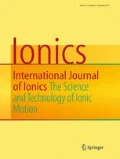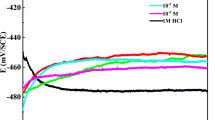Abstract
Isoniazid (anti-biotic) derivatives—PA1 {(E)-N′-(4′-Hydroxy-3-methoxybenzylidene) isonicotino hydrazide}, PA2 {(E)-N′-(Pyridin-4′-ylmethylene) isonicotino hydrazide}, and PA3 {(E)-N′-(Pyridin-3′-ylmethylene) isonicotino hydrazide} were synthesized, characterized, and further examined for corrosion protection activities on mild steel (MS) in 1 M HCl via experimental, theoretical, and surface analysis. Electrochemical processes in the presence of different concentration of tested compounds were characterized as charge transfer controlled and revealed stable, spontaneous corrosion inhibition by inhibitors on mild steel in acidic media. The values evaluated for free energy change (\( \varDelta {G}_{\mathrm{ads}}^0 \)) assured the involvement of chemisorption process. Adsorption data was found well fitted in Langmuir isotherm. Enthalpy and entropy parameters obtained by computational analysis using ADF-band revealed parallel alignment of PA1 on the surface of mild steel as best alignment for optimal adsorption. Theoretically, computed adsorption-free energy (\( \varDelta {G}_{\mathrm{ads}}^0 \)) and adsorption constant (Kads) values for parallel alignment complemented the experimentally determined values.











Similar content being viewed by others
References
Al-Fartusie FS, Mohssan SN (2017) Essential trace elements and their vital roles in human body. Indian J Adv Chem Sci 5:127–136. https://doi.org/10.22607/IJACS.2017.503003
Callister WD Jr (2007) Materials science and engineering: an introduction, 7th edn. John Wiley and Sons, New York
Koch G, Varney J, Thompson N, Moghissi O, Gould M, Payer J International measures of prevention , application , and economics of corrosion technologies study, http://impact.nace.org/documents/Nace-International-Report
Finšgar M, Jackson J (2014) Application of corrosion inhibitors for steels in acidic media for the oil and gas industry: a review. Corros Sci 86:17–41. https://doi.org/10.1016/j.corsci.2014.04.044
Saranya J, Sowmiyac M, Sounthari P, Parameswari K, Chitra S, Senthil Kumar K (2016) N-heterocycles as corrosion inhibitors for mild steel in acid medium. J Mol Liq 216:42–52. https://doi.org/10.1016/j.molliq.2015.12.096
Zheng X, Gong M, Li Q, Guo L (2018) Corrosion inhibition of mild steel in sulfuric acid solution by loquat (Eriobotrya japonica Lindl.) leaves extract. Sci Rep 8:9140. https://doi.org/10.1038/s41598-018-27257-9
Tansug G, Tuken T, Kıcır N, Erbil M (2014) Investigation of 2-aminoethanethiol as corrosion inhibitor for steel using response surface methodology (RSM). Ionics 20:287–294. https://doi.org/10.1007/s11581-013-0966-2
Yıldız R (2019) Adsorption and inhibition effect of 2, 4-diamino-6-hydroxypyrimidine for mild steel corrosion in HCl medium: experimental and theoretical investigation. Ionics 25:859–870. https://doi.org/10.1007/s11581-018-2649-5
Baig N, Chauhan DS, Saleh TA, Quraishi MA (2019) Diethylenetriamine functionalized graphene oxide as a novel corrosion inhibitor for mild steel in hydrochloric acid solutions. New J Chem 43:2328–2337. https://doi.org/10.1039/C8NJ04771E
Rbaa M, Galai M, Benhiba F, Obot IB, Oudda H, Touhami ME, Lakhrissi B, Zarrouk A (2018) Synthesis and investigation of quinazoline derivatives based on 8-hydroxyquinoline as corrosion inhibitors for mild steel in acidic environment: experimental and theoretical studies. Ionics. https://doi.org/10.1007/s11581-018-2817-7
Abdallah M, El-Etre AY, Soliman MG, Mabrouk EM (2006) Some organic and inorganic compounds as inhibitors for carbon steel corrosion in 3.5 percent NaCl solution. Anti-Corrosion Methods Mater 53:118–123. https://doi.org/10.1108/00035590610650820
Singh AK, Thakur S, Pani B, Singh G (2018) Green synthesis and corrosion inhibition study of 2-amino-: N ′-((thiophen-2-yl)methylene)benzohydrazide. New J Chem 42:2113–2124. https://doi.org/10.1039/c7nj04162d
Geethamani P, Kasthuri PK (2015) Adsorption and corrosion inhibition of mild steel in acidic media by expired pharmaceutical drug. Cogent Chem 1:1–11. https://doi.org/10.1080/23312009.2015.1091558
Deng Q, Shi HW, Ding NN, Chen BQ, He XP, Liu G, Tang Y, Long YT, Chen GR (2012) Novel triazolyl bis-amino acid derivatives readily synthesized via click chemistry as potential corrosion inhibitors for mild steel in HCl. Corros Sci 57:220–227. https://doi.org/10.1016/j.corsci.2011.12.014
Palou RM, Olivares-xomelt O, Likhanova NV (2014) Environmentally friendly corrosion inhibitors. In: Aliofkhazraei M (ed) Developments in corrosion protection. IntechOpen Ltd, London, p 431466
Abd El-Lateef HM (2015) Experimental and computational investigation on the corrosion inhibition characteristics of mild steel by some novel synthesized imines in hydrochloric acid solutions. Corros Sci 92:104–117. https://doi.org/10.1016/j.corsci.2014.11.040
Verma C, Quraishi MA, Ebenso EE (2013) Electrochemical studies of 2-amino-1, 9-dihydro-9-((2- hydroxyethoxy) methyl)-6h-purin-6-one as green corrosion inhibitor for mild steel in 1.0 m hydrochloric acid solution. Int J Electrochem Sci 8:7401–7413
Singh AK, Singh P (2015) Adsorption behaviour of o-hydroxy acetophenone benzoyl hydrazone on mild steel/hydrochloric acid interface. J Ind Eng Chem 21:552–560. https://doi.org/10.1016/j.jiec.2014.03.018
Singh AK, Quraishi MA, Ebenso EE (2011) Inhibitive effect of cefuroxime on the corrosion of mild steel in hydrochloric acid solution. Int J Electrochem Sci 6:5676–5688
Aramaki K, Node Y, Nishihara H (1990) Adsorption and corrosion inhibition effect of polar organic compounds on iron in 1M HCI04 containing SH- J Electrochem Soc 137:1354–8. https://doi.org/10.1149/1.2086673
Dibetsoe M, Olasunkanmi LO, Fayemi OE, Yesudass S, Ramaganthan B, Bahadur I, Adekunle A, Kabanda M, Ebenso E (2015) Some phthalocyanine and naphthalocyanine derivatives as corrosion inhibitors for aluminium in acidic medium: experimental, quantum chemical calculations, QSAR studies and synergistic effect of iodide ions. Molecules 20:15701–15734. https://doi.org/10.3390/molecules200915701
Al-Amiery AA, Kadhum AAH, Mohamad AB, Junaedi S (2013) A novel hydrazinecarbothioamide as a potential corrosion inhibitor for mild steel in HCL. Materials (Basel) 6:1420–1431. https://doi.org/10.3390/ma6041420
Singh AK, Thakur S, Pani B, Ebenso EE, Quraishi MA, Pandey AK (2018) 2-Hydroxy- N ′-((Thiophene-2-yl)methylene)benzohydrazide: ultrasound-assisted synthesis and corrosion inhibition study. ACS Omega 3:4695–4705. https://doi.org/10.1021/acsomega.8b00003
Chigondo M, Chigondo F (2016) Recent natural corrosion inhibitors for mild steel: an overview. J Chem 2016:1–7. https://doi.org/10.1155/2016/6208937
Singh AK, Khan S, Singh A, Quraishi SM, Quraishi MA, Ebenso EE (2013) Inhibitive effect of chloroquine towards corrosion of mild steel in hydrochloric acid solution. Res Chem Intermed 39:1191–1208. https://doi.org/10.1007/s11164-012-0677-8
Bedair MA, Fouda AS, Ismail MA, Mostafa A (2018) Inhibitive effect of bithiophene carbonitrile derivatives on carbon steel corrosion in 1 M HCl solution: experimental and theoretical approaches. Ionics. https://doi.org/10.1007/s11581-018-2811-0
Ju H, Kai ZP, Li Y (2008) Aminic nitrogen-bearing polydentate Schiff base compounds as corrosion inhibitors for iron in acidic media: a quantum chemical calculation. Corros Sci 50:865–871. https://doi.org/10.1016/j.corsci.2007.10.009
Singh AK, Thakur S, Pani B, Chugh B, Lgaz H, Chung IM, Chaubey P, Pandey AK, Singh J (2019) Solvent-free microwave assisted synthesis and corrosion inhibition study of a series of hydrazones derived from thiophene derivatives: experimental, surface and theoretical study. J Mol Liq 283:788–803. https://doi.org/10.1016/j.molliq.2019.03.126
Soltani N, Salavati H, Rasouli N, Paziresh M, Moghadasi A (2016) Adsorption and corrosion inhibition effect of Schiff base ligands on low carbon steel corrosion in hydrochloric acid solution. Chem Eng Commun 203:840–854. https://doi.org/10.1080/00986445.2015.1076801
Nasr-Esfahani M, Zendehdel M, Jafari B (2015) Electrochemical and X-ray structural study of corrosion inhibition and adsorption behavior for mild steel by a new Schiff-base cobalt complex in HCl. Prot Met Phys Chem Surfaces 51:285–294. https://doi.org/10.1134/S2070205115020136
Gupta NK, Quraishi MA, Verma C, Mukherjee AK (2016) Green Schiff’s bases as corrosion inhibitors for mild steel in 1 M HCl solution: experimental and theoretical approach. RSC Adv 6:102076–102087. https://doi.org/10.1039/c6ra22116e
Singh AK, Quraishi MA (2010) Investigation of adsorption of isoniazid derivatives at mild steel/hydrochloric acid interface: electrochemical and weight loss methods. Mater Chem Phys 123:666–677. https://doi.org/10.1016/j.matchemphys.2010.05.035
Singh AK, Shukla SK, Quraishi MA, Ebenso EE (2012) Investigation of adsorption characteristics of N,N′-[(methylimino)dimethylidyne]di-2,4-xylidine as corrosion inhibitor at mild steel/sulphuric acid interface. J Taiwan Inst Chem Eng 43:463–472. https://doi.org/10.1016/j.jtice.2011.10.012
Franchini M, Philipsen PHT, Visscher L (2013) The becke fuzzy cells integration scheme in the Amsterdam density functional program suite. J Comput Chem 34:1819–1827. https://doi.org/10.1002/jcc.23323
Te Velde G, Baerends EJ (1991) Precise density-functional method for periodic structures. Phys Rev B 44:7888–7903. https://doi.org/10.1103/PhysRevB.44.7888
Becke AD (1988) Density-fnnctional exchange-energy approximation with correct asymptotic behavior. Phys Rev A 38:3098–3100 1993;98:5648–52. https://doi.org/10.1103/PhysRevA.38.3098
Perdew JP (1986) DFT approximations for the correlation energy of the inhomogeneous electron gas. Phys Rev B 33:8822–8824. https://doi.org/10.1103/PhysRevB.33.8822
Van Lenthe E, Baerends EJ, Snijders JG (1994) Relativistic total energy using regular approximations. J Chem Phys 101:9783–9792. https://doi.org/10.1063/1.467943
Channar PA, Shah SJ, Hassan S, Nisa ZU, Lecka J, Sevigny J, Bajorath J, Saeed A, Iqbal J (2017) Isonicotinohydrazones as inhibitors of alkaline phosphatase and ecto-5′-nucleotidase. Chem Biol Drug Des 89:365–370. https://doi.org/10.1111/cbdd.12861
Myung NV, Park DY, Yoo BY, Sumodjo PTA (2003) Development of electroplated magnetic materials for MEMS. J Magn Magn Mater 265:189–198. https://doi.org/10.1016/S0304-8853(03)00264-6
Arshad N, Akram AR, Akram M, Rasheed I (2017) Triazolothiadiazine derivatives as corrosion inhibitors for copper, mild steel and aluminum surfaces: electrochemical and quantum investigations. Prot Met Phys Chem Surfaces 53:343–358. https://doi.org/10.1134/S2070205117020046
Altaf F, Qureshi R, Ahmed S (2011) Surface protection of copper by azoles in borate buffers-voltammetric and impedance analysis. J Electroanal Chem 659:134–142. https://doi.org/10.1016/j.jelechem.2011.05.013
Sherine HB, Rajendran S (2011) Corrosion inhibition of carbon steel in ground water by thiophenol-Zn2+system. Arab J Sci Eng 36:517–528. https://doi.org/10.1007/s13369-011-0067-3
Saji VS (2010) A review on recent patents in corrosion inhibitors. Recent Patents Corros Sci 2:6–12. https://doi.org/10.2174/1877610801002010006
Amin MT, Alazba AA, Shafiq M (2015) Adsorptive removal of reactive black 5 from wastewater using bentonite clay: isotherms, kinetics and thermodynamics. Sustain 7:15302–15318. https://doi.org/10.3390/su71115302
Oguzie EE (2007) Corrosion inhibition of aluminium in acidic and alkaline media by Sansevieria trifasciata extract. Corros Sci 49:1527–1539. https://doi.org/10.1016/j.corsci.2006.08.009
Martinez S, Stern I (2002) Thermodynamic characterization of metal dissolution and inhibitor adsorption processes in the low carbon steel / mimosa tannin / sulfuric acid system. Appl Surf Sci 199:83–89
Abd El-Maksoud SA, Fouda AS (2005) Some pyridine derivatives as corrosion inhibitors for carbon steel in acidic medium. Mater Chem Phys 93:84–90. https://doi.org/10.1016/j.matchemphys.2005.02.020
Shukla SK, Quraishi MA (2009) 4-substituted anilinomethylpropionate: new and efficient corrosion inhibitors for mild steel in hydrochloric acid solution. Corros Sci 51:1990–1997. https://doi.org/10.1016/j.corsci.2009.05.020
Tiginyanu I, Topala P, Ursaki V (2016) Nanostructures and thin films for multifunctional applications. Springer, Chisinau
Rbaa M, Galai M, El-Faydy M, El-Kacimi Y, Touhami ME (2017) Synthesis and characterization of new benzimidazoles derivatives of 8-hydroxyquinoline as a corrosion inhibitor for mild steel in 1.0 M hydrochloric acid medium. Anal BioanalElectrochem 9:904–928
Jorcin JB, Orazem ME, Pébère N, Tribollet B (2006) CPE analysis by local electrochemical impedance spectroscopy. Electrochim Acta 51:1473–1479. https://doi.org/10.1016/j.electacta.2005.02.128
Li G, Ma H, Jiao Y, Chen S (2004) An impedance investigation of corrosion protection of copper by self-assembled monolayers of alkanethiols in aqueous solution. J Serbian Chem Soc 69:791–805. https://doi.org/10.2298/JSC0410791L
Dhillon S, Kant R (2017) Theory for electrochemical impedance spectroscopy of heterogeneous electrode with distributed capacitance and charge transfer resistance. J Chem Sci 129:1277–1292. https://doi.org/10.1007/s12039-017-1335-x
Mo S, Li LJ, Luo HQ, Li NB (2017) An example of green copper corrosion inhibitors derived from flavor and medicine: vanillin and isoniazid. J Mol Liq 242:822–830. https://doi.org/10.1016/j.molliq.2017.07.081
Ahamad I, Prasad R, Quraishi MA (2010) Thermodynamic, electrochemical and quantum chemical investigation of some Schiff bases as corrosion inhibitors for mild steel in hydrochloric acid solutions. Corros Sci 52:933–942. https://doi.org/10.1016/j.corsci.2009.11.016
Becke AD (1993) Density-functional thermochemistry. III. The role of exact exchange. J Chem Phys 98:5648–5652. https://doi.org/10.1063/1.464913
Lee C, YoungW, Parr RG (1989) Development of the Colle-Salvetti correlation-energy formula into a functional of the electron density. Phys Rev A 162:165–169. https://doi.org/10.1103/PhysRevB.37.785
Zarrouk A, Hammouti B, Dafali A, Bouachrine M, Zarrok H, Boukhris S, al-Deyab SS (2014) A theoretical study on the inhibition efficiencies of some quinoxalines as corrosion inhibitors of copper in nitric acid. J Saudi Chem Soc 18:450–455. https://doi.org/10.1016/j.jscs.2011.09.011
Olsen RA, Kroes GJ, Baerends EJ (1999) Atomic and molecular hydrogen interacting with Pt(111). J Chem Phys 111:11155–11163. https://doi.org/10.1063/1.480473
Franchini M, Philipsen PHT, Van Lenthe E, Visscher L (2014) Accurate Coulomb potentials for periodic and molecular systems through density fitting. J Chem Theory Comput 10:1994–2004. https://doi.org/10.1021/ct500172n
PallassanaV, Neurock M, Bruno HL, Hammer B, Nørskov J (1999) Theoretical analysis of hydrogen chemisorption on pd(111), re(0001) and (formula presented) (formula presented) pseudomorphic overlayers. Phys Rev B - Condens Matter Mater Phys 60:6146–6154. https://doi.org/10.1103/PhysRevB.60.6146
Acknowledgments
This research is supported by the Department of Chemistry, Allama Iqbal Open University, and Islamabad, Pakistan. Author Bhawna Chugh is thankful to NSIT, New Delhi, India for providing financial support as TRF to perform this research work. We are also thankful to our colleagues from respective Institution who assisted directly or indirectly for this research work. The authors are immensely grateful to reviewers for their comments that greatly improved the manuscript.
Author information
Authors and Affiliations
Corresponding authors
Ethics declarations
Conflict of interest
The authors declare that there is no conflict of interest.
Additional information
Publisher’s note
Springer Nature remains neutral with regard to jurisdictional claims in published maps and institutional affiliations.
Electronic supplementary material
ESM 1
(DOCX 1883 kb)
Rights and permissions
About this article
Cite this article
Arshad, N., Singh, A.K., Chugh, B. et al. Experimental, theoretical, and surface study for corrosion inhibition of mild steel in 1 M HCl by using synthetic anti-biotic derivatives. Ionics 25, 5057–5075 (2019). https://doi.org/10.1007/s11581-019-03028-y
Received:
Revised:
Accepted:
Published:
Issue Date:
DOI: https://doi.org/10.1007/s11581-019-03028-y




